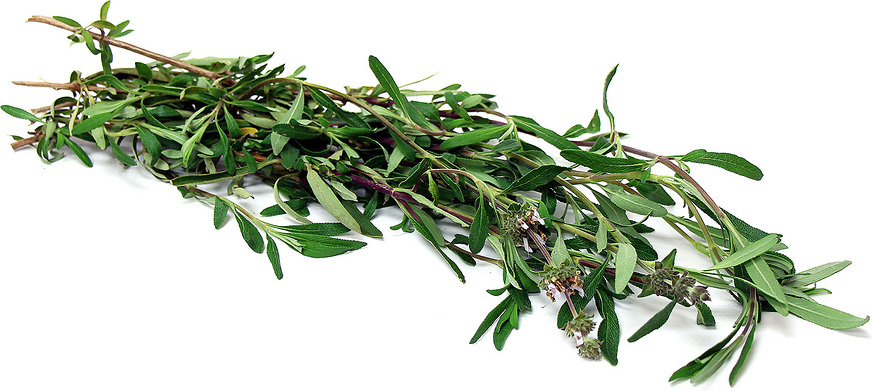


Black Sage
Estimated Inventory, lb : 0
Description/Taste
Black Sage is a powerfully fragrant, woody shrub that quickly grows to an average of one meter in height and width, though more mature plants can reach up to 1.8 meters. The plant has tiny hairs coating the stems and leaves in a silver-green fuzz, and flowers that range from white to pale blue or lavender grow in spherical clusters, known as whorls, along the square stems. The small, oval, dark-green pebbled leaves can look almost black from a distance, especially during dry conditions, and the stem and whorls harden and turn black at the end of the season—all characteristics believed to have influenced the plant’s name. Black Sage leaves produce a strong, herbal, sometimes minty scent and offer a mildly astringent, herbaceous flavor.
Seasons/Availability
Black Sage is available year-round, blooming in the spring through mid-summer.
Current Facts
Black Sage is botanically classified as Salvia mellifera and is in the largest genus of the Lamiaceae or mint family alongside all other true sages. It shares its species name with the Western honeybee, or Apis mellifera, which translates from Latin to “honey-bearing.” Indeed, the nectar of the Black Sage plant is highly sought out by beekeepers as it produces delicious, uniquely peppery honey, and hence the plant is also commonly known as Honey Sage. It is a keystone species of the plant communities in southern California. Many insects and animals depend on it for survival, and its absence would start a detrimental domino within the ecosystem. Recently, populations of Black Sage have been decreasing due to loss of habitat and competition with non-native grasses, so the planting of Black Sage in native habitat gardens or backyards has been encouraged.
Nutritional Value
Sages are known to have a healthy dose of vitamins and minerals, as well as antioxidants that have been linked to certain health benefits, from improved memory to brain functioning. Black Sage contains natural pain-relieving chemical compounds, like diterpenoids, and has strong anti-inflammatory properties. Essential oil made from the plant has also been shown to have antimicrobial effects, as well as possible antispasmodic, antiseptic, and astringent properties. The plant’s tiny seeds are high in protein and were often harvested by Native Americans as food, either eaten raw or ground into meal.
Applications
Black Sage leaves are used fresh or dried as an aromatic and flavorful herb in cooking. You can substitute Black Sage in recipes that call for common sage, just keep in mind that foraged Black Sage has a much stronger earthy flavor than that of traditional store-bought varieties. It pairs well with winter squashes, brown butter, poultry, venison, pears, cheese, potatoes, and other herbs such as rosemary and thyme. The leaves can also be used in tea, traditionally used to treat digestive, circulatory, and respiratory ailments.
Ethnic/Cultural Info
Native Americans have historically used black Sage for medicinal purposes. The Chumash people, native to the coastal region from Malibu to San Luis Obispo, would make a sun tea from the plant’s leaves and stems used as a topical pain reliever or soak, especially for feet. Similarly, the Kumeyaay people through Baja, Mexico to San Diego would bathe in a tea made from the leaves and stems to treat flu, rheumatism, and arthritis. The Ohlone people of California’s Bay Area would place warm leaves inside the ear to relieve earaches, chew fresh leaves to alleviate gas, and consume a decoction of leaves and stems as a cough suppressant. Black Sage has also traditionally been used in the ritual cleansing process of burning herbs known as smudging and is said to promote restful sleep and vivid dreams. However, it’s important to note that another widespread plant is used for smudging called mugwort, most commonly referring to the species Artemisia vulgaris, which is also nicknamed “dream weed” or “black sage.” While mugwort and true Black Sage plants do share similar properties and benefits, Artemisia-based smudges may contain minor amounts of thujone, a mildly trance-inducing compound famously found in absinthe liqueur.
Geography/History
Black Sage is native to regions from central California south through Baja California with low to medium elevation. It’s a drought-resistant plant that prefers full sun, thriving equally well on sandy beach areas as a coastal sage scrub and dry hills of chaparral habitat. It is the most widespread of the California Salvia species and can now be found growing all along the state's coast as far north as the Bay Area. It’s a keystone species that provides food and habitation for butterflies, bees, small mammals, and birds. It is popularly used in erosion control and re-vegetation projects, as well as in native landscaping in California. Some biologists even use it as a natural indicator of pollution levels as it’s highly sensitivity to sulfur dioxide and ozone air pollutants.
Recipe Ideas
Recipes that include Black Sage. One




